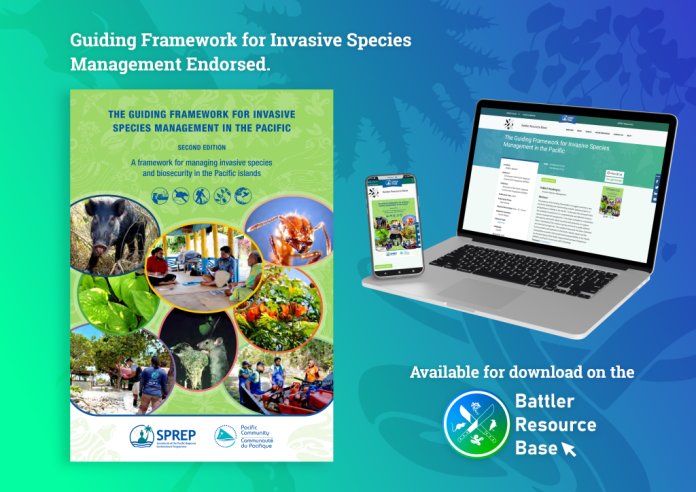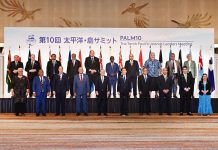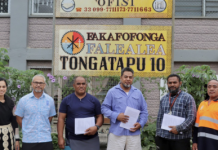Invasive species are a threat to Pacific communities, they are destructive to native biodiversity and the natural environment and have major socio-economic impacts on communities and national development. Considered “the most significant driver of population declines and species extinctions in island ecosystems worldwide”, invasive species cause extensive economic loss and compromise human health.
To curb the devastating impact of invasive species on Pacific communities, SPREP Members who gathered in Samoa for the 31st SPREP Meeting of Officials, endorsed the second edition of the Guiding Framework for Invasive Species Management in the Pacific.
The Guiding Framework is to support anyone or any institution planning and implementing invasive species projects or programmes on islands in the Pacific. To this end, the document lists the essential components of a comprehensive and effective invasive species management programme. The development of the Guiding Framework was funded by the GEF 6 Regional Invasive Project (GEF6 RIP) – Strengthening national and regional capacities to reduce the impact of Invasive Alien Species on globally significant biodiversity in the Pacific.
SPREP Invasive Species Adviser, David Moverley, said the endorsement of the Guiding Framework for Invasive Species Management in the Pacific: Second Edition is critical to efforts being made to combat the impact of invasive species on native plants, animals and ecosystems.
“Pacific islands are particularly vulnerable to invasive species because of their isolation. Vulnerable sites and ecosystems for the Pacific islands include their near-shore marine communities,” said Moverley. “Pacific island native species and communities have not evolved to cope with the impacts of invasive predators, herbivores, insects, weeds, and diseases. They are therefore particularly vulnerable to the establishment of invasive species populations and to the subsequent damage they cause.”
The Guiding Framework
All these impacts are exacerbated for small island states because they often have limited human, material, and financial resources available to prevent and respond to such threats. Without the support provided through tools like the Guiding Framework the negative impact of invasive species will continue to increase, causing biodiversity and ecosystem loss.
The Guiding Framework was compiled in consultation with experts and Pacific island countries and territories, to support them in developing their invasive species work and to guide regional and international agencies. It provides a framework for designing, planning and monitoring invasive species, management and biosecurity for the Pacific islands, and guides the process for setting priorities and the development and implementation of National Invasive Species Strategies and Action Plans (NISSAP).
The 31st SPREP Meeting of Officials and associated meetings took place at Taumeasina Island Resort in Samoa, from 4-8 September 2023. The meetings were guided by the theme: SPREP@30th Sustainable, transformative and resilient for a Blue Pacific. The meetings brought together SPREP’s 21 Pacific Island Member countries, 5 Metropolitan Members and partners to discuss strategic issues pertaining to the organisation, and to approve the 2024-2025 work plan.
The endorsement of the Guiding Framework for Invasive Species Management in the Pacific: Second Edition was one of many environment-related outcomes from the meeting. The Guiding Framework addresses invasive plants, animals, disease agents, and other organisms in marine, freshwater, and terrestrial environments and aligns directly with relevant international conventions and standards and is intended to assist planners and practitioners in meeting accepted standard operating procedures.
“During the compilation of this document, contributions were received from many individuals, including the formal review group, SPREP Invasives Team, PRISMSS Partners, and other colleagues, representing many countries and territories of the Pacific as well as regional and international organisations working in the region,” said Moverley.
The Guiding Framework is available in English and French on the Battler Resource Base.
The GEF 6 RIP is funded by the Global Environment Facility, implemented by the United Nations Environment Programme, and executed by the Secretariat of the Pacific Regional Environment Programme.
The Project works primarily in the Marshall Islands, Niue, Tonga, and Tuvalu and has a regional component. Implementation of the GEF6 RIP is supported by the Pacific Regional Invasive Species Management Support Service.
For more information on the GEF 6 RIP, please contact Project Manager GEF 6 RIP Isabell Rasch at isabellr@sprep.org
SOURCE: SPREP/PACNEWS


















